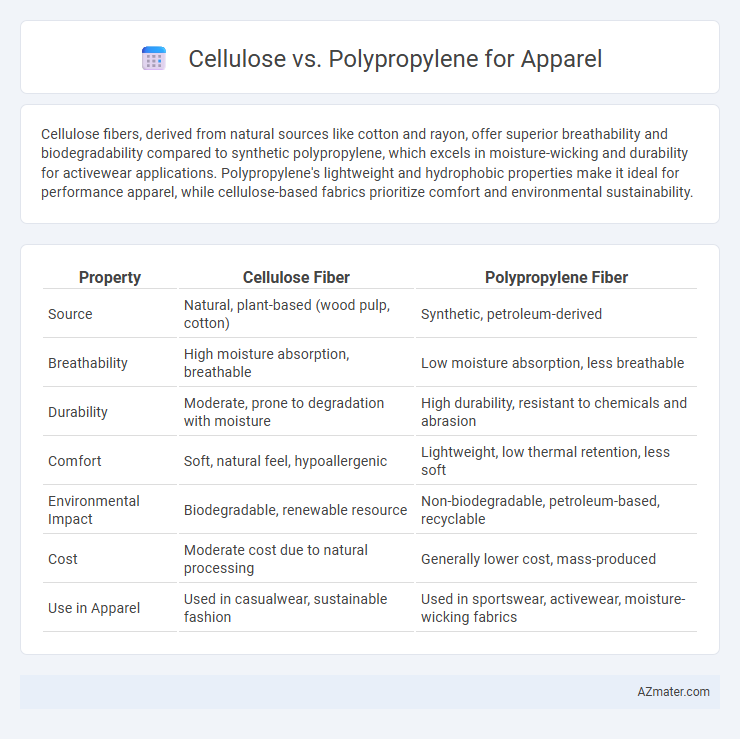Cellulose fibers, derived from natural sources like cotton and rayon, offer superior breathability and biodegradability compared to synthetic polypropylene, which excels in moisture-wicking and durability for activewear applications. Polypropylene's lightweight and hydrophobic properties make it ideal for performance apparel, while cellulose-based fabrics prioritize comfort and environmental sustainability.
Table of Comparison
| Property | Cellulose Fiber | Polypropylene Fiber |
|---|---|---|
| Source | Natural, plant-based (wood pulp, cotton) | Synthetic, petroleum-derived |
| Breathability | High moisture absorption, breathable | Low moisture absorption, less breathable |
| Durability | Moderate, prone to degradation with moisture | High durability, resistant to chemicals and abrasion |
| Comfort | Soft, natural feel, hypoallergenic | Lightweight, low thermal retention, less soft |
| Environmental Impact | Biodegradable, renewable resource | Non-biodegradable, petroleum-based, recyclable |
| Cost | Moderate cost due to natural processing | Generally lower cost, mass-produced |
| Use in Apparel | Used in casualwear, sustainable fashion | Used in sportswear, activewear, moisture-wicking fabrics |
Introduction to Cellulose and Polypropylene in Apparel
Cellulose fibers, derived from natural sources like cotton and wood pulp, offer breathability, moisture absorption, and biodegradability, making them ideal for sustainable apparel. Polypropylene, a synthetic thermoplastic polymer, provides lightweight, moisture-wicking, and durable properties often used in performance and activewear. Understanding the distinct characteristics of cellulose and polypropylene helps designers optimize fabric choices based on comfort, functionality, and environmental impact in apparel manufacturing.
Chemical Composition and Structure
Cellulose is a natural polymer composed of glucose units linked by b-1,4-glycosidic bonds, forming long, linear chains that provide biodegradability and moisture absorption in apparel fibers like cotton and rayon. Polypropylene is a synthetic polyolefin consisting of repeating propylene monomers with a hydrocarbon backbone, offering hydrophobicity, chemical resistance, and high tensile strength, making it suitable for activewear and industrial textiles. The fundamental difference in chemical composition--cellulose's polysaccharide structure versus polypropylene's hydrocarbon polymer--directly influences their durability, comfort, and environmental impact in textile applications.
Production Processes Compared
Cellulose fibers, derived from natural sources like cotton or wood pulp, undergo chemical treatments such as viscose or lyocell processes involving cellulose dissolution and regeneration, which require extensive water and energy usage but result in biodegradable fabric. Polypropylene, a synthetic polymer produced through polymerization of propylene monomers, uses a melt-spinning technique that is energetically efficient and produces fibers resistant to moisture and chemicals but is non-biodegradable. The production of cellulose fibers emphasizes renewable raw materials and biodegradability, while polypropylene prioritizes cost-effective manufacturing with high durability and moisture resistance.
Environmental Impact and Sustainability
Cellulose fibers, derived from natural sources like wood pulp, are biodegradable and have a lower carbon footprint compared to polypropylene, a petroleum-based synthetic fiber known for its persistence in the environment and contribution to microplastic pollution. The production of cellulose fibers typically consumes less energy and water than polypropylene, making it more sustainable for apparel manufacturing. Choosing cellulose-based fabrics supports circularity and reduces reliance on fossil fuels, aligning with eco-friendly and sustainable fashion practices.
Performance and Durability in Clothing
Cellulose fibers, such as cotton and viscose, offer excellent breathability and moisture absorption, enhancing comfort in apparel but tend to degrade faster with repeated washing and exposure to UV light. Polypropylene provides superior durability and resistance to wear, abrasion, and chemical exposure, maintaining structural integrity even under heavy use, making it ideal for performance garments. The choice between cellulose and polypropylene depends on balancing natural comfort with long-lasting resilience in clothing applications.
Comfort and Breathability
Cellulose fibers such as cotton and viscose offer superior comfort and breathability compared to polypropylene, as their natural porous structure allows better moisture absorption and air circulation. In contrast, polypropylene is hydrophobic and traps heat and sweat against the skin, making it less suitable for garments requiring ventilation. Apparel made from cellulose enhances thermal regulation and reduces skin irritation, which is essential for activewear and everyday clothing.
Cost Considerations in Apparel Manufacturing
Cellulose fibers, such as cotton and viscose, generally incur higher raw material and processing costs compared to polypropylene, which is a synthetic polymer known for its low production expense. Polypropylene's cost-effectiveness stems from its inexpensive petrochemical base and simpler manufacturing techniques, making it attractive for large-scale apparel production. However, the higher price of cellulose fabrics reflects their superior breathability, biodegradability, and consumer demand for sustainable fashion, which can influence overall cost structures and pricing strategies in apparel manufacturing.
Applications in Fashion and Sportswear
Cellulose fibers such as lyocell and viscose offer superior breathability, moisture-wicking, and biodegradability, making them ideal for sustainable fashion and athletic wear that demands comfort and environmental responsibility. Polypropylene excels in sportswear through its lightweight, hydrophobic properties, rapid drying time, and excellent thermal insulation, enhancing performance in high-intensity activities and outdoor sports. The choice between cellulose and polypropylene depends on desired fabric characteristics, balancing eco-friendliness with performance requirements in modern apparel design.
Consumer Preferences and Trends
Consumer preferences for apparel increasingly favor cellulose fibers due to their biodegradability, moisture-wicking properties, and natural origin, aligning with sustainability trends. Polypropylene remains popular for activewear because of its durability, lightweight nature, and excellent thermal resistance, appealing to performance-driven consumers. Market data highlights a rising demand for eco-friendly materials, with cellulose-based fabrics experiencing a growth rate exceeding 7% annually compared to polypropylene's steady 3% growth.
Future Prospects in Textile Innovation
Cellulose fibers, derived from renewable resources, are gaining momentum in textile innovation for their biodegradability and comfort, making them a sustainable alternative to synthetic fibers like polypropylene. Polypropylene remains favored for its durability, moisture-wicking properties, and resistance to chemicals, positioning it as a practical choice in performance apparel. Future prospects in textile innovation involve hybrid fabrics combining cellulose-based fibers with polypropylene to enhance sustainability while maintaining functionality, driven by increasing consumer demand for eco-friendly and high-performance materials.

Infographic: Cellulose vs Polypropylene for Apparel
 azmater.com
azmater.com